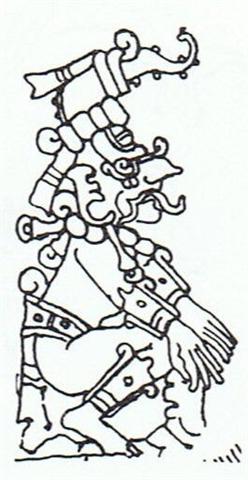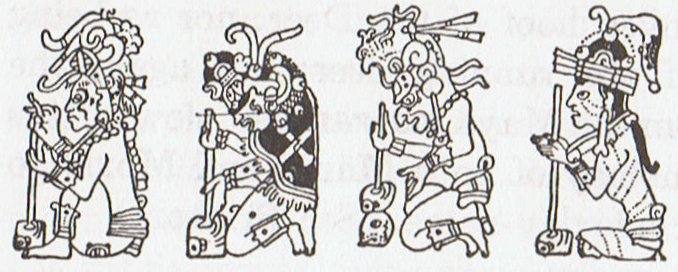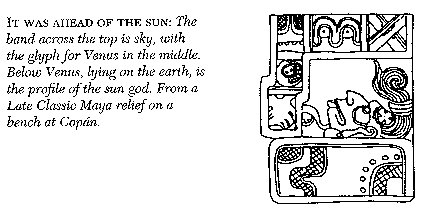275. The Pleiades arrived in May 15 (500 = 365 + 135 = 4 * 91 + 136). And at the time of the Bull there were 8 days from Alcyone, Pleione, and Atlas, to day 365 counted from 0h, the same measure as that for the dark nights of Venus before she returned to visibility as Morning Star:
The youngster looking ahead in Gb5-12 is looking up as in that Raingod panel which is following the One when he is sitting on a coffin (sarcophagus, flesh eater):
A week before this youngster the star Porrima (γ Virginis) had culminated at 21h in the timespace (right ascension) day of May 17, corresponding both to "April 6 (96) and to 3-14 at the time of the Bull, which should make us remember the Chinese customs: ... In China, every year about the beginning of April, certain officials called Sz'hüen used of old to go about the country armed with wooden clappers. Their business was to summon the people and command them to put out every fire. This was the beginning of the season called Han-shih-tsieh, or 'eating of cold food'. For three days all household fires remained extinct as a preparation for the solemn renewal of the fire, which took place on the fifth or sixth day after the winter solstice [Sic!] ... Because when Atlas (and the rest of his family) culminated (at 21h) it was in December 31.
In other words, if the Chinese had regarded the end of the year to be at Tau-ono (6 'stones' = 6 stars), then the following Foundation Stone (Temennu) would have marked the first (zero) day of the next year.
And if the correct position of the Foundation Stone (Chinese: Hairy Head) should be in December 31 according to the Sun calendar (because this was its day zero),
then the Chines customs will make a kind of sense. Their winter solstice was probably not in December 21 (which reflects the Gregorian spring equinox date March 21) but rather in December 25 (as in the date 'March 25 for the Julian equinox). December 25 is day 359 in the Gregorian calendar, but counting from its zero day (4 * 91 + 1) its number will be 360. And '5 or 6' days after day 360 the new fire was ignited, this will bring us to the night straddling December 30 and 31. 3 days of cold food could then be understood as those days corresponding to (355) Gb5-1, Gb5-2, and Gb5-3 at Tau-ono. The Chinese may have recollected - or reconstructured - a time when Atlas had risen together with the Sun at the end of a 3-night long solstice. Here we should remember that Julius Caesar had inserted 62 days (July and August) in the calendar and 136 - 62 = 74 = 1 + 73 (3-14). At the time of Bharani (*41 precessional days earlier than the time of rongorongo) Acrux would have culminated (at 21h) in "April 2 (92 + 366 = 378 = the synodic circuit of Saturn). In the long nights of winter the stars could have been consulted for telling the time until Acrux culminated in "April 2 when the wooden clappers announced how Father Light was about to return. The element of Jupiter was wood (as in all cultures) and via friction (or otherwise) dry old wood would catch fire.
The Chinese correspondence table suggest this fire-making wood should preferably be ignited by means of a copper (Venus) mirror:
... The life-force of the earth is water. God moulded the earth with water. Blood too he made out of water. Even in a stone there is this force, for there is moisture in everything. But if Nummo is water, it also produces copper. When the sky is overcast, the sun's rays may be seen materializing on the misty horizon. These rays, excreted by the spirits, are of copper and are light. They are water too, because they uphold the earth's moisture as it rises. The Pair excrete light, because they are also light ... 'The sun's rays,' he went on, 'are fire and the Nummo's excrement. It is the rays which give the sun its strength. It is the Nummo who gives life to this star, for the sun is in some sort a star.' It was difficult to get him to explain what he meant by this obscure statement. The Nazarene made more than one fruitless effort to understand this part of the cosmogony; he could not discover any chink or crack through which to apprehend its meaning. He was moreover confronted with identifications which no European, that is, no average rational European, could admit. He felt himself humiliated, though not disagreeably so, at finding that his informant regarded fire and water as complementary, and not as opposites. The rays of light and heat draw the water up, and also cause it to descend again in the form of rain. That is all to the good. The movement created by this coming and going is a good thing. By means of the rays the Nummo draws out, and gives back the life-force. This movement indeed makes life. The old man realized that he was now at a critical point. If the Nazarene did not understand this business of coming and going, he would not understand anything else. He wanted to say that what made life was not so much force as the movement of forces. He reverted to the idea of a universal shuttle service. 'The rays drink up the little waters of the earth, the shallow pools, making them rise, and then descend again in rain.' Then, leaving aside the question of water, he summed up his argument: 'To draw up and then return what one had drawn - that is the life of the world.'
... The ceremony was performed with great pomp by the same officials who procured the new fire from heaven by reflecting the sun's rays either from a metal mirror or from a crystal on dry moss. Fire thus obtained is called by the Chinese heavenly fire and its use is enjoined in sacrifices: whereas fire elicited by the friction of wood is termed by them earthly fire, and its use is prescribed for cooking and other domestic purposes ... Like archaic China and certain Amero-Indian societies, Europe, until quite recently, celebrated a rite involving the extinguishing and renewal of domestic fires, preceded by fasting and the use of the instruments of darkness. This series of events took place just before Easter, so that the 'darkness' which prevailed in the church during the service of the same name (Tenebrae), could symbolize both the extinguishing of domestic fires and the darkness which covered the earth at the moment of Christ's death. In all Catholic countries it was customary to extinguish the lights in the churches on Easter Eve and then make a new fire sometimes with flint or with the help of a burning-glass. Frazer brings together numerous instances which show that this fire was used to give every house new fire. He quotes a sixteenth-century Latin poem in a contemporary English translation, from which I take the following significant lines: On Easter Eve the fire all is quencht in every place, // And fresh againe from out the flint is fecht with solemne grace. Then Clappers cease, and belles are set againe at libertée, // And herewithall the hungrie times of fasting ended bée ...
... What happens after (or happened, or will happen sometime, for this myth is written in the future tense), is told in the Völuspa, but it is also amplified in Snorri's Gylfaginning (53), a tale of a strange encounter of King Gylfi with the Aesir themselves, disguised as men, who do not reveal their identity but are willing to answer questions: 'What happens when the whole world has burned up, the gods are dead, and all of mankind is gone? You have said earlier, that each human being would go on living in this or that world.' So it is, goes the answer, there are several worlds for the good and the bad. Then Gylfi asks: 'Shall any gods be alive, and shall there be something of earth and heaven?' And the answer is: 'The earth rises up from the sea again, and is green and beautiful and things grow without sowing. Vidar and Vali are alive, for neither the sea nor the flames of Surt have hurt them and they dwell on the Eddyfield, where once stood Asgard. There come also the sons of Thor, Modi and Magni, and bring along his hammer. There come also Balder and Hoder from the other world. All sit down and converse together. They rehearse their runes and talk of events of old days. Then they find in the grass the golden tablets that the Aesir once played with. Two children of men will also be found safe from the great flames of Surt. Their names, Lif and Lifthrasir, and they feed on the morning dew and from this human pair will come a great population which will fill the earth. And strange to say, the sun, before being devoured by Fenrir, will have borne a daughter, no less beautiful and going the same ways as her mother.' Then, all at once, concludes Snorri's tale wryly, a thunderous cracking was heard from all sides, and when the King looked again, he found himself on the open plain and the great hall had vanished ... Gb5-12 is 'cracked' and so is Ga1-6:
... In day 150 (May 30, 80 + 70 = 300 / 2) the Janus type of division illustrated in Ga1-6 has benevolent light in front but a dark figure with an egoistically sucking elbow shown at the back side, giving no light at all away ... The division of Ga1-6 into past and future resembles that of Gb6-26 and possibly it means there were not 8 but 8 + 6 = 14 nights before the 'Eye' of Blood Moon entered up into full view again from the Underground (Xibalba). ... Now go up there on the face of the earth; you will not die. Keep the word. So be it, said the head of One and Seven Hunaphu - they were of one mind when they did it ...
Gb5-12 would then represent the last (360) day of a regular year:
The beginning should be in the dark (under ground) and Hyadum I (γ) was at the origin of light, where the dark forces were defeated:
... Nut, whom the Greeks sometimes identified with Rhea, was goddess of the sky, but it was debatable if in historical times she was the object of a genuine cult. She was Geb's twin sister and, it was said, married him secretly and against the will of Ra. Angered, Ra had the couple brutally separated by Shu and afterwards decreed that Nut could not bear a child in any given month of any year. Thoth, Plutarch tells us, happily had pity on her. Playing draughts with the Moon, he won in the course of several games a seventy-second part of the Moon's light with which he composed five new days. As these five intercalated days did not belong to the official Egyptian calendar of three hundred and sixty days, Nut was thus able to give birth successively to five children: Osiris, Haroeris (Horus), Set, Isis and Nepthys ... If the Sun year on Ester Island was regarded as needing 366 days, then there could have been 360 / 72 + 1 = 6 days outside the regular course of days. This idea would then explain why in the C text there were special glyphs in the corresponding places early on side a and side b:
... And then she looked in her hand, she inspected it right away, but the bone's saliva wasn't in her hand. It is just a sign I have given you, my saliva, my spittle. This, my head, has nothing on it - just bone, nothing of meat. It's just the same with the head of a great lord: it's just the flesh that makes his face look good. And when he dies, people get frightened by his bones. After that, his son is like his saliva, his spittle, in his being, whether it be the son of a lord or the son of a craftsman, an orator. The father does not disappear, but goes on being fulfilled. Neither dimmed nor destroyed is the face of a lord, a warrior, craftsman, an orator. Rather, he will leave his daughters and sons. So it is that I have done likewise through you. Now go up there on the face of the earth; you will not die. Keep the word. So be it, said the head of One and Seven Hunaphu - they were of one mind when they did it ...
|
||||||||||||||||||||||||||||||||||||||||||||||||||||||||||||||||||||||||||||||||||||||||||||||||||||||||||||||||||||||||||||||||||||||||||||||||||||||||||||||||||||||||||||||||||||||||||||||||||||||||||||||||||||||||||||||||||||||||||||||||||||||||||





















